| ID |
Date |
Author |
Topic |
Subject |
|
2831
|
11 Sep 2024 |
Konstantin Olchanski | Forum | Python frontend rate limitations? | > I'm trying to get a sense of the rate limitations of a python frontend.
1) python is single-threaded, for ultimate performance, a MIDAS frontend (or any DAQ
application) has to be multithreaded:
a) thread with busy loop read the data and place it into a FIFO
b) thread to read data from FIFO and send it to SYSTEM buffer shared memory or to
mserver
c) thread to respond to begin-run, end-run, etc RPCs
d) probably a thread to recycle memory from thread (b) back to thread (a) if per-event
malloc()/free() adds too much overhead
2) data readout. C++ AXI bus access is compiled into 1 instruction and results in 1 AXI
bus operation. comparable for python likely has much more overhead, slows you down.
3) event bank filling. C++ for() loop is compiled into very compact machine code,
python loop cannot because each array element can be random data type, shows you down.
bottom line, there is a reason high speed data acquisitions are written in C/C++, not
in shell, perl, tcl/tk, or (today's favourite) python.
> The C++ frontend is about 100 times faster in both data and event rates.
This is as expected. You can probably improve python code to get closer to 10 times
slower than C++. But consider:
a) will it be "fast enough" for the task?
b) learning C++ and optimizing python to within "2-3-10x slower than C++" may involve a
similar amount of time and effort.
And you have not looked at the real-time properties of your frontend. You may discover
that it's actually faster than you think, but occasionally stops for a millisecond (or
two or hundred). some applications a notorious for running memory garbage collection
just at the wrong time.
I am working right now on exactly this problem, I have a 1 GHz ARM CPU (Cyclone-V FPGA)
and I need to push data out at 100 Mbytes/sec while avoiding and bad-real-time dropouts
that cause the FPGA data FIFO to overflow. And I only have 2 CPU cores, 1 to read the
FPGA FIFO, 1 to run the TCP/IP stack and the ethernet driver. No this can be done with
python.
K.O. |
|
2832
|
11 Sep 2024 |
Konstantin Olchanski | Forum | Python frontend rate limitations? | >
> poll(INT count) {
> for (i=0 ; i<count ; i++)
> if (new_event())
> return TRUE;
> return FALSE;
> }
in the c++ frontend (tmfe.h) this loop usually runs in a separate thread, and I am now working on the linux magic to assign this thread maximum
uninterruptible priority. otherwise on my Cyclone-V FPGA SoC I see 1-10 msec dropouts, I think from taking ethernet interrupts.
K.O. |
|
2833
|
11 Sep 2024 |
Konstantin Olchanski | Forum | Python frontend rate limitations? | > > I'm trying to get a sense of the rate limitations of a python frontend.
forgot one more:
c++ toolchain comes with extensive profiler tools aimed to answer the question "why is my
program so slow, where is it spending all the time?". some of these tools go all the way to
the hardware level and report CPU cache misses, TLB flushes, context switches and any other
hardware events that interrupt or slow down computations. programmer than uses this
information to restructure the code to avoid the worst slow downs (i.e. avoid branch mis-
predictions, avoid cache misses, etc).
I doubt the python toolchain will ever profiler tools as good.
K.O. |
|
2838
|
11 Sep 2024 |
Konstantin Olchanski | Forum | "Safe" abort of sequencer scripts | > We often use the MIDAS sequencer to temporarily control detector settings, such as:
>
> * <change some setting>
> * WAIT 60 seconds
> * <revert setting to original value>
>
> The question arises of what happens if the sequencer scripts gets aborted during that wait, preventing the value from being reset.
Common problem. Go have an elegant solution using the "defer" keyword.
https://go.dev/tour/flowcontrol/12
K.O. |
|
2860
|
27 Sep 2024 |
Ben Smith | Forum | Python frontend rate limitations? | > in your case the limitation is likely that you're sending 1.25MB per event and we have a lot of data marshalling to do between the python and C++ layer.
>
> I'll add it to my to-do list to investigate improving the performance of medium-to-large events in the python code.
I've now added better support for numpy arrays in the python code that encodes a `midas.event.Event` object. If you use the "correct" numpy data type then you can get vastly improved performance as numpy already stores the data in memory in the format that we need.
In your example, if you change
self.zero_buffer = [0] * self.total_data_size
to
self.zero_buffer = np.ndarray(self.total_data_size, np.int16)
then the max data rate of the frontend goes from 330MB/s to 7600MB/s on my laptop (a factor 20 improvement from one line of code!)
To ensure you're using the optimal numpy dtype for your bank, you can reference a dict called `midas.tid_np_formats`. For example `midas.tid_np_formats[midas.TID_SHORT]` is equivalent to `np.int16`. If you use an int16 array and write it as a TID_SHORT bank, then we'll use the fast path. If there is a mismatch, we'll have to do type conversions and will end up on the slow path. |
|
2885
|
05 Nov 2024 |
Jack Carlton | Forum | How to properly write a client listens for events on a given buffer? | If there's some template for writing a client to access event data, that would be
very useful (and you can probably just ignore the context I gave below in that
case).
Some context:
Quite a while ago, I wrote the attached "data pipeline" client whose job was to
listen for events, copy their data, and pipe them to a python script. I believe I
just stole bits and pieces from mdump.cxx to accomplish this. Later I wrote the
attached wrapper class "MidasConnector.cpp" and a main.cpp to generalize
data_pipeline.cxx a bit. There were a lot of iterations to the code where I had the
below problems; so don't take the logic in the attached code as the exact code that
caused the issues below.
However, I'm unable to resolve a couple issues:
1. If a timeout is set, everything will work until that timeout is reached. Then
regardless of what kind of logic I tried to implement (retry receiving event,
disconnect and reconnect client, etc.) the client would refuse to receive more data.
2. When I ctrl-C main, it hangs; this is expected because it's stuck in a while
loop. But because I can't set a timeout I have to ctrl-C twice; this would
occasionally corrupt the ODB which was not ideal. I was able to get around this with
some impractical solution involving ncurses I believe.
Thanks,
Jack |
| Attachment 1: data_pipeline_(2).cxx
|
#include "midas.h"
#include "msystem.h"
#include "mrpc.h"
#include "mdsupport.h"
#include <iostream>
#include <unistd.h>
#include <stdio.h> // Added for popen
#include <stdlib.h> // Added for malloc and free
INT hBufEvent;
void process_event(EVENT_HEADER *pheader) {
printf("Received event #%d\n", pheader->serial_number);
printf("Event ID: %d\n", pheader->event_id);
printf("Data Size: %d bytes\n", pheader->data_size);
printf("Timestamp: %d\n", pheader->time_stamp);
printf("Trigger mask: %d\n", pheader->trigger_mask);
// Print a marker to indicate the start of serialized data
printf("EVENT_DATA_START\n");
// Serialize and print the event data
int* eventData = (int*)((char*)pheader + sizeof(EVENT_HEADER));
int numIntegers = (pheader->data_size - sizeof(EVENT_HEADER)) / sizeof(int);
for (int i = 0; i < 8; ++i) {
printf("%d ", eventData[i]);
}
printf("\n");
// Process the event here
}
int main() {
HNDLE hDB, hKey;
char host_name[HOST_NAME_LENGTH], expt_name[NAME_LENGTH], str[80];
char buf_name[32] = EVENT_BUFFER_NAME, rep_file[128];
unsigned int status, start_time, stop_time;
INT ch, request_id, size, get_flag, action, single, i;
// Define the maximum event size you expect to receive
INT max_event_size = 4000;
// Allocate memory for storing event data dynamically
void* event_data = malloc(max_event_size);
printf("1\n");
/* Get if existing the pre-defined experiment */
cm_get_environment(host_name, sizeof(host_name), expt_name, sizeof(expt_name));
// Print host_name
printf("host_name = %s\n", host_name);
// Print expt_name
printf("expt_name = %s\n", expt_name);
printf("2\n");
/* connect to the experiment */
status = cm_connect_experiment(host_name, expt_name, "data_pipeline", 0);
if (status != CM_SUCCESS) {
return 1;
}
printf("3\n");
status = bm_open_buffer(buf_name, DEFAULT_BUFFER_SIZE, &hBufEvent);
if (status != BM_SUCCESS && status != BM_CREATED) {
cm_msg(MERROR, "data_pipeline", "Cannot open buffer \"%s\", bm_open_buffer() status %d", buf_name, status);
return 1;
}
printf("4\n");
/* set the buffer cache size if requested */
bm_set_cache_size(hBufEvent, 100000, 0);
printf("5\n");
/* place a request for a specific event id */
status = bm_request_event(hBufEvent, EVENTID_ALL, TRIGGER_ALL, GET_ALL, &request_id, NULL); // Use NULL as the callback routine
printf("6\n");
printf("status = %d\n",status);
// Open a pipe to a Python script for data transfer
FILE* pipe = popen("python3 data_pipeline.py", "w");
if (pipe == NULL) {
perror("popen");
return 1;
}
// Enter the event processing loop
while (1) {
// Use the address of max_event_size in bm_receive_event
status = bm_receive_event(hBufEvent, event_data, &max_event_size, BM_WAIT); // Wait for new data indefinitely
if (status == BM_SUCCESS) {
//process_event((EVENT_HEADER*)((char*)event_data + sizeof(EVENT_HEADER)));
// Send the event data to the Python script via the pipe
fprintf(pipe, "EVENT_DATA_START\n");
int* eventData = (int*)((char*)event_data + sizeof(EVENT_HEADER));
int numIntegers = (max_event_size - sizeof(EVENT_HEADER)) / sizeof(int);
for (int i = 4; i < 12; ++i) {
fprintf(pipe, "%d ", eventData[i]);
}
fprintf(pipe, "\n");
fflush(pipe); // Flush the buffer to ensure data is sent immediately
} else {
printf("Error receiving event: %d\n", status);
break; // Exit the loop if an error occurs
}
}
// Close the pipe
pclose(pipe);
// Free the dynamically allocated memory
free(event_data);
cm_disconnect_experiment();
printf("7\n");
return 1;
}
|
| Attachment 2: MidasConnector.cpp
|
#include "MidasConnector.h"
MidasConnector::MidasConnector(const char* clientName) {
// Initialize client name
strncpy(client_name_, clientName, NAME_LENGTH);
// Get host name and experiment name from environment
cm_get_environment(host_name_, sizeof(host_name_), experiment_name_, sizeof(experiment_name_));
// Initialize other private variables if needed
event_id = EVENTID_ALL; // Initialize with default value
trigger_mask = TRIGGER_ALL; // Initialize with default value
sampling_type = GET_ALL; // Initialize with default value (renamed from get_flags)
buffer_size = DEFAULT_BUFFER_SIZE; // Initialize with default value
timeout_millis = BM_WAIT;
strncpy(buffer_name, EVENT_BUFFER_NAME, sizeof(buffer_name)); // Initialize with default value
}
// Getters for the private variables
short MidasConnector::getEventId() const {
return event_id;
}
short MidasConnector::getTriggerMask() const {
return trigger_mask;
}
int MidasConnector::getSamplingType() const {
return sampling_type;
}
int MidasConnector::getBufferSize() const {
return buffer_size;
}
const char* MidasConnector::getBufferName() const {
return buffer_name;
}
int MidasConnector::getTimeout() const {
return timeout_millis;
}
HNDLE MidasConnector::getEventBufferHandle() const {
return hBufEvent;
}
// Setters for the private variables
void MidasConnector::setEventId(short eventId) {
event_id = eventId;
}
void MidasConnector::setTriggerMask(short triggerMask) {
trigger_mask = triggerMask;
}
void MidasConnector::setSamplingType(int samplingType) {
sampling_type = samplingType;
}
void MidasConnector::setBufferSize(int bufferSize) {
buffer_size = bufferSize;
}
void MidasConnector::setBufferName(const char* bufferName) {
strncpy(buffer_name, bufferName, sizeof(buffer_name));
}
void MidasConnector::setTimeout(int timeoutMillis) {
timeout_millis = timeoutMillis;
}
void MidasConnector::setEventBufferHandle(HNDLE eventBufferHandle) {
hBufEvent = eventBufferHandle;
}
bool MidasConnector::ConnectToExperiment() {
// Connect to the experiment
int status = cm_connect_experiment(host_name_, experiment_name_, client_name_, NULL);
if (status != CM_SUCCESS) {
// Handle connection error
return false;
}
return true;
}
void MidasConnector::DisconnectFromExperiment() {
// Disconnect from the experiment
cm_disconnect_experiment();
}
bool MidasConnector::OpenEventBuffer() {
int status = bm_open_buffer(buffer_name, buffer_size, &hBufEvent);
if (status != BM_SUCCESS && status != BM_CREATED) {
cm_msg(MERROR, client_name_, "Cannot open buffer \"%s\", bm_open_buffer() status %d", buffer_name, status);
return false;
}
return true;
}
bool MidasConnector::SetCacheSize(int cacheSize) {
bm_set_cache_size(hBufEvent, cacheSize, 0);
return true;
}
bool MidasConnector::RequestEvent() {
int request_id;
int status = bm_request_event(hBufEvent, event_id, trigger_mask, sampling_type, &request_id, NULL);
return status == BM_SUCCESS;
}
bool MidasConnector::ReceiveEvent(void* eventBuffer, int& maxEventSize) {
int status = bm_receive_event(hBufEvent, eventBuffer, &maxEventSize, timeout_millis);
return status == BM_SUCCESS;
}
|
| Attachment 3: main.cpp
|
#include "event_processor/EventProcessor.h"
#include "data_transmitter/DataTransmitter.h"
#include "midas_connector/MidasConnector.h"
#include "json.hpp"
#include <fstream>
INT hBufEvent1;
INT hBufEvent2;
// Function to initialize MIDAS and open an event buffer
bool initializeMidas(MidasConnector& midasConnector, const nlohmann::json& config) {
// Set the MidasConnector properties based on the config
midasConnector.setEventId(config["eventId"].get<short>());
midasConnector.setTriggerMask(config["triggerMask"].get<short>());
midasConnector.setSamplingType(config["samplingType"].get<int>());
midasConnector.setBufferSize(config["bufferSize"].get<int>());
midasConnector.setBufferName(config["bufferName"].get<std::string>().c_str());
midasConnector.setBufferSize(config["bufferSize"].get<int>());
// Call the ConnectToExperiment method
if (!midasConnector.ConnectToExperiment()) {
return false;
}
// Call the OpenEventBuffer method
if (!midasConnector.OpenEventBuffer()) {
return false;
}
// Set the buffer cache size if requested
midasConnector.SetCacheSize(config["cacheSize"].get<int>());
// Place a request for a specific event id
if (!midasConnector.RequestEvent()) {
return false;
}
return true;
}
int main() {
// Read configuration from a JSON file
nlohmann::json config;
std::ifstream configFile("config.json");
configFile >> config;
configFile.close();
// Initialize MidasConnector and connect to the MIDAS experiment
MidasConnector midasConnector(config["clientName"].get<std::string>().c_str());
if (!initializeMidas(midasConnector, config)) {
printf("Error: Failed to initialize MIDAS.\n");
return 1;
}
// Read the maximum event size from the JSON configuration
INT max_event_size = config["maxEventSize"].get<int>();
// Allocate memory for storing event data dynamically
void* event_data = malloc(max_event_size);
// Initialize EventProcessor with detector mapping file and verbosity flag
EventProcessor eventProcessor(config["detectorMappingFile"].get<std::string>(), config["verbose"].get<bool>());
// Initialize DataTransmitter with the ZeroMQ address
DataTransmitter dataPublisher(config["zmqAddress"].get<std::string>());
// Connect to the ZeroMQ server
if (!dataPublisher.bind()) {
// Handle connection error
printf("Error: Failed to bind to port %s.\n", config["zmqAddress"].get<std::string>().c_str());
return 1;
} else {
printf("Connected to the ZeroMQ server.\n");
}
// Event processing loop
while (true) {
midasConnector.ReceiveEvent(event_data, max_event_size);
//Prcoess data once we have it
eventProcessor.processEvent(event_data, max_event_size);
// Serialize the event data with EventProcessor and store it in serializedData
std::string serializedData = eventProcessor.getSerializedData();
// Send the serialized data to the ZeroMQ server with DataTransmitter
if (!dataPublisher.publish(serializedData)) {
// Handle send error
printf("Error: Failed to send serialized data.\n");
}
}
// Cleanup and finalize your application
midasConnector.DisconnectFromExperiment(); // Disconnect from the MIDAS experiment
return 0;
}
|
|
2886
|
05 Nov 2024 |
Maia Henriksson-Ward | Forum | How to properly write a client listens for events on a given buffer? | > If there's some template for writing a client to access event data, that would be
> very useful (and you can probably just ignore the context I gave below in that
> case).
>
>
> Some context:
>
> Quite a while ago, I wrote the attached "data pipeline" client whose job was to
> listen for events, copy their data, and pipe them to a python script. I believe I
> just stole bits and pieces from mdump.cxx to accomplish this. Later I wrote the
> attached wrapper class "MidasConnector.cpp" and a main.cpp to generalize
> data_pipeline.cxx a bit. There were a lot of iterations to the code where I had the
> below problems; so don't take the logic in the attached code as the exact code that
> caused the issues below.
>
> However, I'm unable to resolve a couple issues:
>
> 1. If a timeout is set, everything will work until that timeout is reached. Then
> regardless of what kind of logic I tried to implement (retry receiving event,
> disconnect and reconnect client, etc.) the client would refuse to receive more data.
>
> 2. When I ctrl-C main, it hangs; this is expected because it's stuck in a while
> loop. But because I can't set a timeout I have to ctrl-C twice; this would
> occasionally corrupt the ODB which was not ideal. I was able to get around this with
> some impractical solution involving ncurses I believe.
>
>
> Thanks,
> Jack
midas/examples/lowlevel/consume.cxx might be what you're looking for, but I think all
you're missing is a call to cm_yield() in your loop, so your midas client doesn't get
killed when the timeout is reached (and also so you can act on shutdown requests from
midas)
Something like
int status = cm_yield(100);
if (status == SS_ABORT || status == RPC_SHUTDOWN)
break;
There might be a recommended way to handle the ctrl-c and disconnect from the ODB, but
off the top of my head I don't remember it.
Also check out Ben's new(ish) python library, midas/python/examples/event_receiver.py
might be a much easier solution. And you can use the context manager, which will take
care of safely disconnecting from midas after you ctrl-C. |
|
2914
|
02 Dec 2024 |
Stefan Ritt | Forum | "Safe" abort of sequencer scripts | The atexit() function has been implemented in the current develop branch of midas, see
https://daq00.triumf.ca/MidasWiki/index.php/Sequencer#ATEXIT_subroutine
Stefan |
|
2926
|
29 Dec 2024 |
Pavel Murat | Forum | time ordering of run transition calls to TMFeEquipment things | Dear MIDAS experts,
I have a question about "tmfe approach" to implementing MIDAS frontends. If I read the code correctly,
within this approach it is the TMFeEquipment things, not the TMFrontend's themselves,
which handle the run transitions - the TMFrontend class
https://bitbucket.org/tmidas/midas/src/423082fb67c7711813fcda61f7cd03784c398f49/include/tmfe.h#lines-306:378
simply doesn't have methods to handle those directly.
So how does a user control the sequence in which TMFeEquipment::HandleBeginRun functions of different
TMFeEquipment pieces are called at begin run? - there are two cases to consider: TMFeEquipment things
defined by the same TMFrontend and by different TMFrontend's.
Many thanks and happy holidays to everyone!
-- regards, Pasha
|
|
2927
|
01 Jan 2025 |
Konstantin Olchanski | Forum | time ordering of run transition calls to TMFeEquipment things | > I have a question about "tmfe approach" to implementing MIDAS frontends. If I read the code correctly,
> within this approach it is the TMFeEquipment things, not the TMFrontend's themselves,
> which handle the run transitions - the TMFrontend class
that's correct and it is documented so in https://bitbucket.org/tmidas/midas/src/develop/tmfe.md
> So how does a user control the sequence in which TMFeEquipment::HandleBeginRun functions of different
> TMFeEquipment pieces are called at begin run? - there are two cases to consider: TMFeEquipment things
> defined by the same TMFrontend and by different TMFrontend's.
I am not sure what you are trying to do. It is always easier to suggest a solution to a specific problem.
But I will try to answer anyway:
1) "time ordering of run transitions" - of course midas transitions are ordered by transition sequence numbers
and the tmfe class provides methods to control this. ditto for the mfe.cxx frontends.
2) for one TMFrontend, the order of calling HandleBeginRun() is the order in which equipments were added to the
equipment using FeAddEquipment(). HandleEndRun() is called in reverse order. (I better check this).
3) to have multiple TMFrontends in one program would be unusual (mfe.cxx frontends completely do not support
this), but should work. Everything was coded to support this, but it was never tested in practice because we
cannot invent any useful use-case for it. HandleBeginRun() handlers are likely to be called in the frontends are
created. (I could check this and confirm it works, as long as you have a valid use-case for this configuration).
4) Frontend X has EquipmentA and EquipmentB, you want EqA::HandleBeginRun() to be called at run transition 200
and EqB::HandleBeginRun() to be called at run transition 400.
This is not directly supported by mfe.cxx frontends (the begin_run() handler is a global function) and I did not
directly implement it in the TMFE frontend.
But I think this would be a useful improvement. I will look into this.
Likely I will add per-equipment data members fEqConfBeginRunSeqNo, fEqConfEndRunSeqno, etc. Value 0 would
unregister the corresponding run transition handler. This would cleanup the code quite a bit, a bunch
of RegisterTranstionXXX functions could go away.
K.O. |
|
2928
|
02 Jan 2025 |
Pavel Murat | Forum | time ordering of run transition calls to TMFeEquipment things | Hi K.O., your clarification is much appreciated!
"
> I am not sure what you are trying to do. It is always easier to suggest a solution to a specific problem.
I think, I owe you an explanation :) :
Consider ~ 40 nodes with two FPGAs (PCIE cards) per node, talking to the detector hardware.
One of those FPGAs, in addition to reading the data, performs the global timing synchronization.
The high-bandwidth data readout is not controlled by MIDAS, so all frontends perform only 'slow control'-type functions.
In MIDAS language, an FPGA implements two different units of slow control equipment:
one - configuring and controlling a single FPGA (equipment type A), and another one - synchronizing
multiple FPGAs (equipment type B). On one of the nodes, unit A and unit B share the FPGA card,
so they better be controlled by the same frontend.
For one, I need to make sure that all type A equipment units, managed by multiple frontends,
are initialized before the [single] type B unit which shares the frontend with the type A unit.
And, of course, the end of a run transition has to be handled in the opposite order - type B unit
shuts down first.
As 'periodic' actions for all registered pieces of equipment are performed in the same loop [thread],
registering the equipment in the needed order - first A, then B - should give a solution - thanks for making that clear.
>
> 1) "time ordering of run transitions" - of course midas transitions are ordered by transition sequence numbers
> and the tmfe class provides methods to control this. ditto for the mfe.cxx frontends.
>
> 2) for one TMFrontend, the order of calling HandleBeginRun() is the order in which equipments were added to the
> equipment using FeAddEquipment(). HandleEndRun() is called in reverse order. (I better check this).
the ordering of the rpc handler calls in tmfe's tr_stop/tr_pause/tr_resume functions is ok.
>
> 3) to have multiple TMFrontends in one program would be unusual (mfe.cxx frontends completely do not support
> this), but should work. Everything was coded to support this, but it was never tested in practice because we
> cannot invent any useful use-case for it. HandleBeginRun() handlers are likely to be called in the frontends are
> created. (I could check this and confirm it works, as long as you have a valid use-case for this configuration).
agreed, I don't think there is a good use case for that, so no need to spend time checking.
>
> 4) Frontend X has EquipmentA and EquipmentB, you want EqA::HandleBeginRun() to be called at run transition 200
> and EqB::HandleBeginRun() to be called at run transition 400.
>
> This is not directly supported by mfe.cxx frontends (the begin_run() handler is a global function) and I did not
> directly implement it in the TMFE frontend.
>
> But I think this would be a useful improvement. I will look into this.
In the simplest case, registering the equipment units in the right order is definitely the answer.
However a single FPGA can perform multiple logically independent tasks and thus represent
multiple logical units of equipment. Those units however are not independent: they share the hardware (FPGA)
and thus do depend on each other. Giving users a full control over the sequence in which those logical units
execute their run transitions is quite likely to be needed, for example, to work around peculiarities of the
custom-made kernel drivers.
>
> Likely I will add per-equipment data members fEqConfBeginRunSeqNo, fEqConfEndRunSeqno, etc. Value 0 would
> unregister the corresponding run transition handler. This would cleanup the code quite a bit, a bunch
> of RegisterTranstionXXX functions could go away.
this also makes sense. -- thanks again, regards, Pasha
>
> K.O. |
|
2929
|
05 Jan 2025 |
Stefan Ritt | Forum | time ordering of run transition calls to TMFeEquipment things | Hi Pavel,
have you looked into
cm_set_transition_sequence()
which let's you define the sequence number for every midas client. You give any number between 1 and 1000 (default is 500 for frontends I believe).
The default value of 500 is defined in mfe.cxx:2641 where you have 500 for all four transitions, but it can be overwritten in the frontend_init function via
cm_set_transition_sequence(). Since you have separate values for the start and stop transition, you can get the different sequencing for both transitions as you need. Like set
all type A to 400, type B to 600 for TR_START, and set type A to 600 and type B to 400 for TR_STOP.
Since this works on the midas client level, it should also work for the tmfe.cxx framework. I'm however not sure if you have a similar default of 500 as in mfe.cxx:2641. But K.O.
should know.
Best,
Stefan |
|
2932
|
18 Jan 2025 |
Pavel Murat | Forum | mjsonrpc: how to increase the max allowed length of the callback response ? | Dear MIDAS experts,
I'm using MIDAS javascript interface (mjsonrpc) to communicate with a frontend from a custom web page
and observe that the if the frontend's response exceeds certain number of bytes, it is always truncated.
MIDAS C/C++ RPC interface allows users to specify the max response length :
https://daq00.triumf.ca/MidasWiki/index.php/Remote_Procedure_Calls_(RPC)#C++_2
How would one do the same from with mjsonrpc ?
-- many thanks, regards, Pasha |
|
2933
|
20 Jan 2025 |
Ben Smith | Forum | mjsonrpc: how to increase the max allowed length of the callback response ? | > I'm using MIDAS javascript interface (mjsonrpc) to communicate with a frontend from a custom web page
> and observe that the if the frontend's response exceeds certain number of bytes, it is always truncated.
>
> MIDAS C/C++ RPC interface allows users to specify the max response length :
>
> https://daq00.triumf.ca/MidasWiki/index.php/Remote_Procedure_Calls_(RPC)#C++_2
>
> How would one do the same from with mjsonrpc ?
I just documented the max_reply_length (javascript) and max_len (python) parameters on that page. Both are optional and default to 1024 bytes.
I also added a link to the full mjsonrpc schema https://daq00.triumf.ca/MidasWiki/index.php/Mjsonrpc#Schema_(List_of_all_RPC_methods) . You can also find the auto-generated schema on any midas installation by going to the "Help" webpage served by mhttpd and clicking the "JSON-RPC schema" > "text table format" link. |
|
2934
|
30 Jan 2025 |
Pavel Murat | Forum | converting non-MIDAS slow control data into MIDAS history format ? | Dear MIDAS experts,
I have a time series of slow control measurements in an ASCII format -
data records in a format (run_number, time, temperature, voltage1, ..., voltageN),
and, if possible, would like to convert them into a MIDAS history format.
Making MIDAS events out of that data is easy, but is it possible to preserve
the time stamps? - Logically, this boils down to whether it is possible to have
the event time set by a user frontend
-- as always - many thanks, regards, Pasha |
|
2935
|
31 Jan 2025 |
Pavel Murat | Forum | converting non-MIDAS slow control data into MIDAS history format ? | I think I found an answer to my question: a user-controlled event header does have a time stamp:
https://daq00.triumf.ca/MidasWiki/index.php/Event_Structure#Event_Header
-- apologies for the spam, regards, Pasha |
|
2937
|
05 Feb 2025 |
Andreas Suter | Forum | Transition from mana -> manalyzer | Hi,
we are planning to migrate from mana to manalyzer. I started to have a look into it and realized that I have some lose ends.
Is there a clear migration docu somewhere?
Currently I understand it the following way (which might be wrong):
The class TARunObject is used to write analyzer modules which are registered by TAFactory. I hope this is right?
However, in mana there is an analyzer implemented by the user which binds the modules and has additional routines:
analyzer_init(), analyzer_exit(), analyzer_loop()
ana_begin_of_run(), ana_end_of_run(), ana_pause_run(), ana_resume_run()
which we are using.
This part I somehow miss in manalyzer, most probably due to lack of understanding, and missing documentation.
Could somebody please give me a boost? |
|
2938
|
05 Feb 2025 |
Andrea Capra | Forum | Transition from mana -> manalyzer | Hi Andreas,
please find in elog:2938/1 a short introduction that I wrote sometime ago.
I'm glad to offer additional support, if needed.
> Hi,
>
> we are planning to migrate from mana to manalyzer. I started to have a look into it and realized that I have some lose ends.
> Is there a clear migration docu somewhere?
>
> Currently I understand it the following way (which might be wrong):
> The class TARunObject is used to write analyzer modules which are registered by TAFactory. I hope this is right?
>
> However, in mana there is an analyzer implemented by the user which binds the modules and has additional routines:
> analyzer_init(), analyzer_exit(), analyzer_loop()
> ana_begin_of_run(), ana_end_of_run(), ana_pause_run(), ana_resume_run()
> which we are using.
>
> This part I somehow miss in manalyzer, most probably due to lack of understanding, and missing documentation.
>
> Could somebody please give me a boost? |
| Attachment 1: dsadc_analyzer_midas_elog.pdf
|
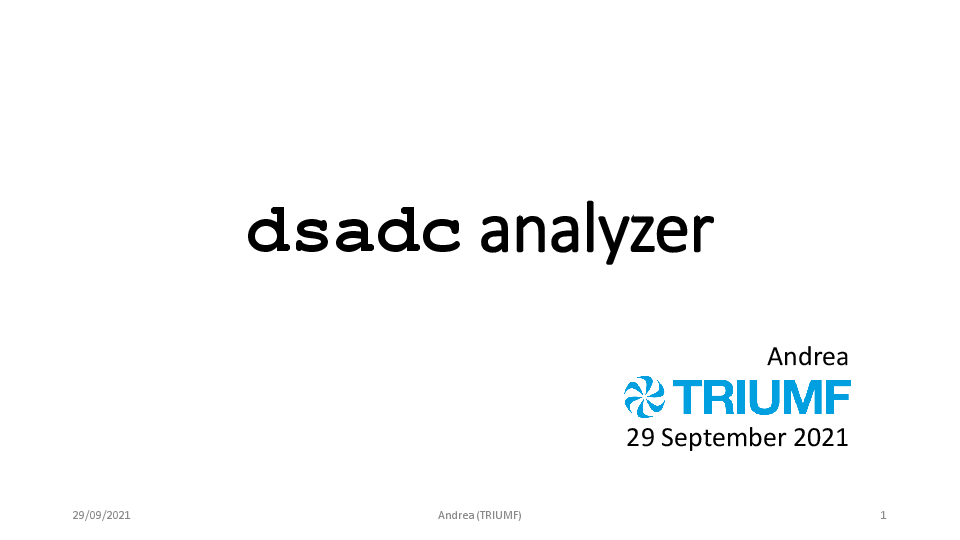
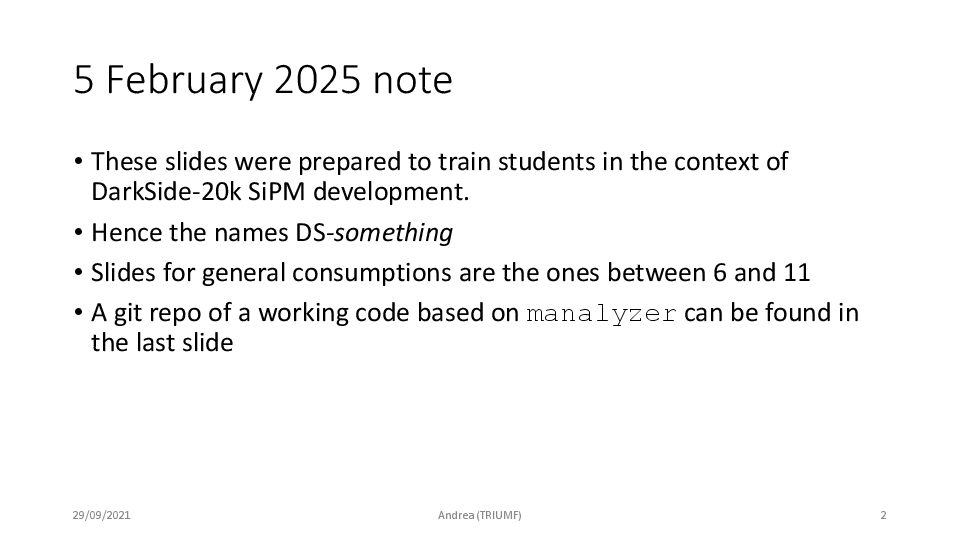
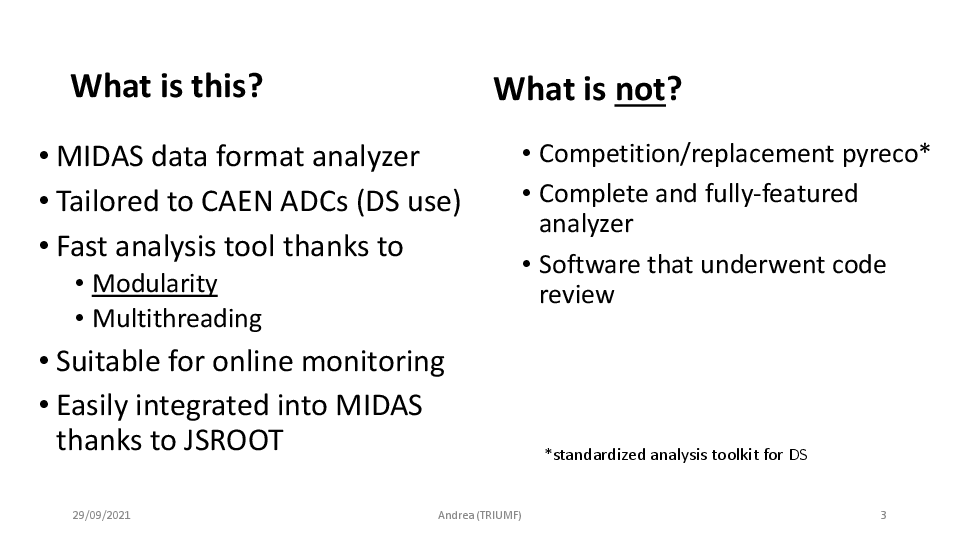
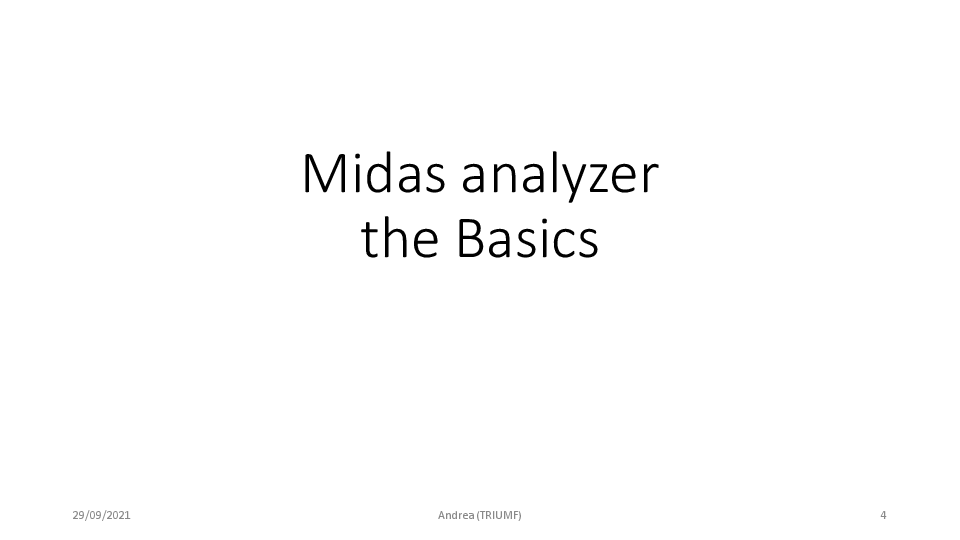
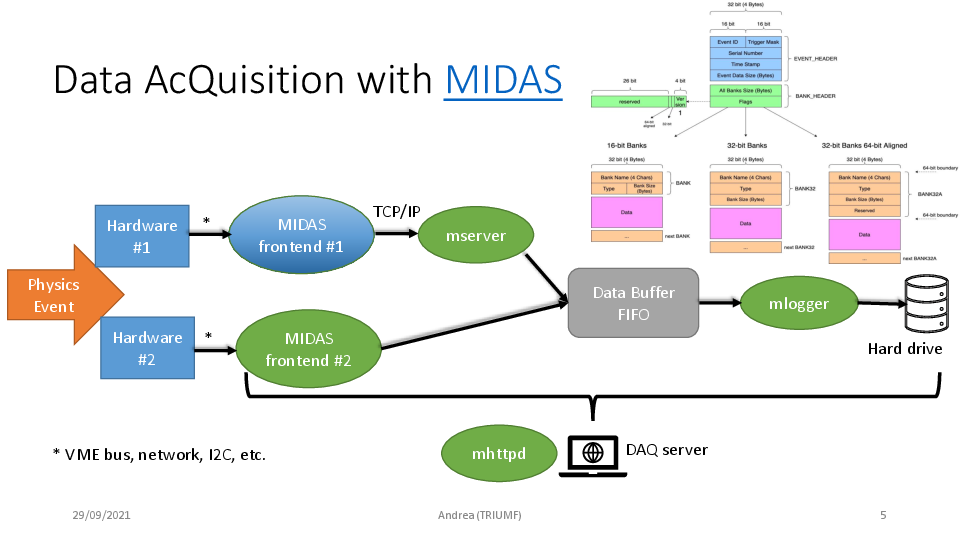
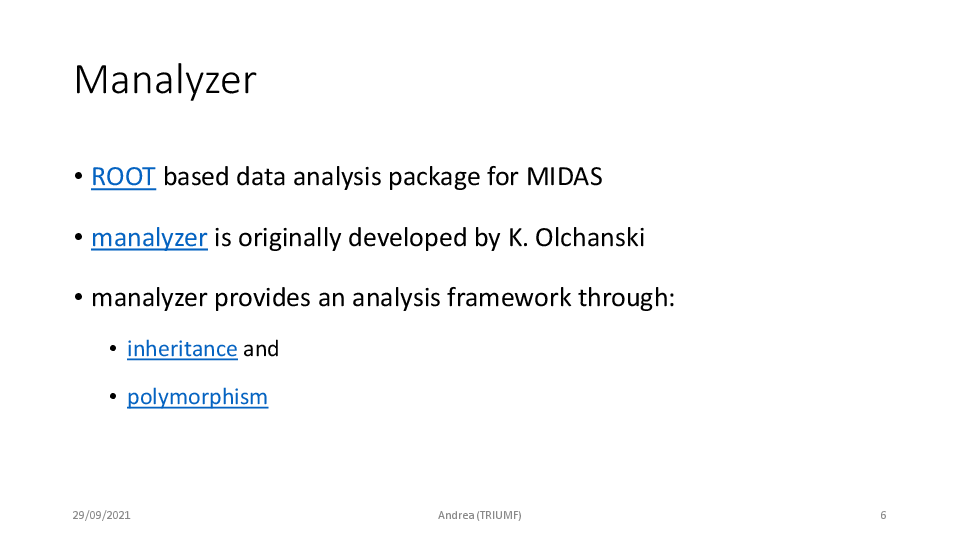
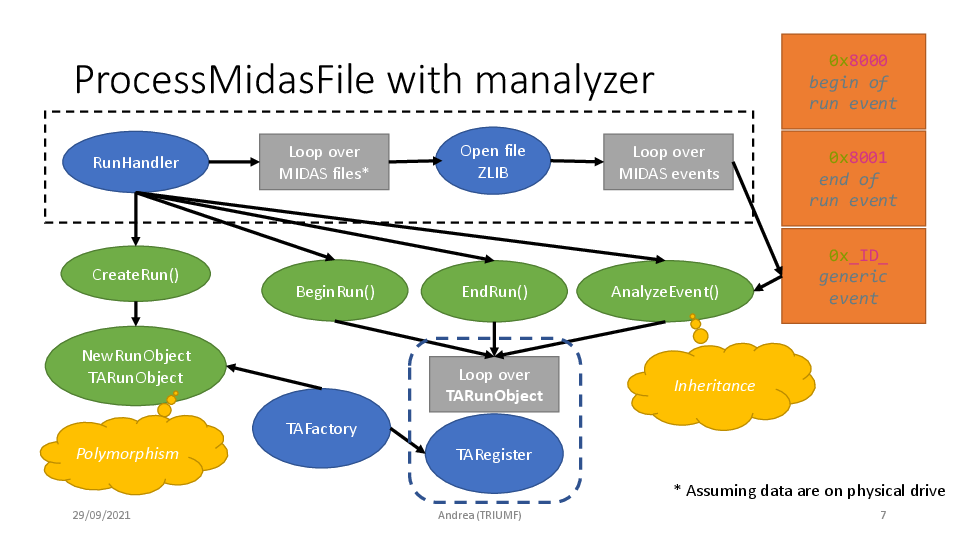
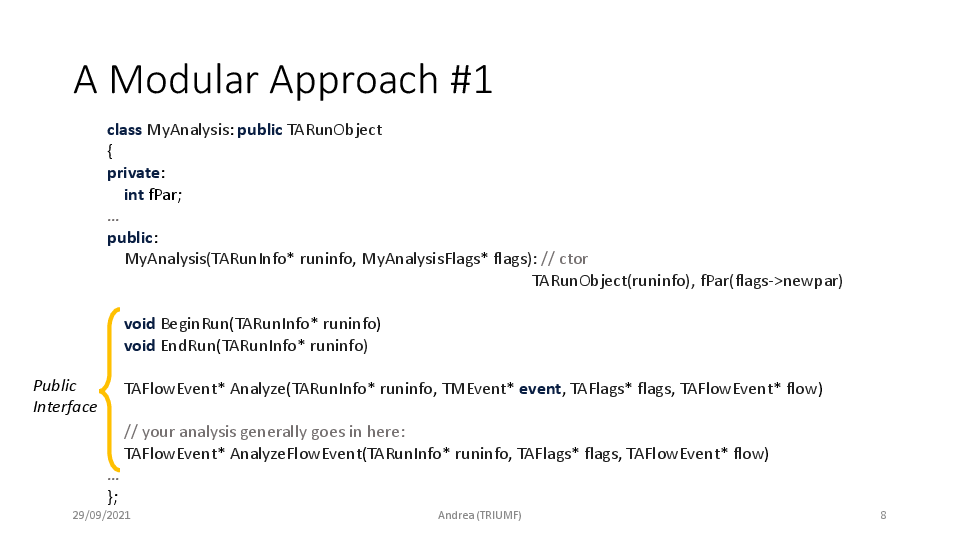
|
|
2939
|
06 Feb 2025 |
Konstantin Olchanski | Forum | Transition from mana -> manalyzer | > Could somebody please give me a boost?
no need to shout into the void, it is pretty easy to identify the author of manalyzer and ask me directly.
> we are planning to migrate from mana to manalyzer. I started to have a look into it and realized that I have some lose ends.
> Is there a clear migration docu somewhere?
README.md and examples in the manalyzer git repository.
If something is missing, or unclear, please ask.
> Currently I understand it the following way (which might be wrong):
> The class TARunObject is used to write analyzer modules which are registered by TAFactory. I hope this is right?
Please read the README file. It explains what is going on there.
Design of manalyzer had 2 main goals:
a) lifetime of all c++ objects (and ROOT objects) is well defined (to fix a design defect in rootana)
b) event flow and data flow are documentable (problem in mfe.c frontends, etc)
> However, in mana there is an analyzer implemented by the user which binds the modules and has additional routines:
> analyzer_init(), analyzer_exit(), analyzer_loop()
> ana_begin_of_run(), ana_end_of_run(), ana_pause_run(), ana_resume_run()
> which we are using.
I have never used the mana analyzer, I wrote the c++ rootana analyzer very early on (first commit in 2006).
But the basic steps should all be there for you:
- initialization (create histograms, open files) can be done in the module constructor or in BeginRun()
- finalization (fit histograms, close files) should be done in EndRun()
- event processing (obviously) in Analyze()
- pause run, resume run and switch to next subrun file have corresponding methods
- all the "flow" and multithreading stuff you can ignore to first order.
To start the migration, I recommend you take manalyzer_example_root.cxx and start stuffing it with your code.
If you run into any problems, I am happy to help with them. Ask here or contact me directly.
> This part I somehow miss in manalyzer, most probably due to lack of understanding, and missing documentation.
True, I wrote a migration guide for the frontend mfe.c to c++ tmfe, because we do this migration
quite often. But I never wrote a migration guide from mana.c analyzer, because we never did such
migration. Most experiments at TRIUMF are post-2006 and use rootana in it's different incarnations.
P.S. I designed the C++ TMFe frontend after manalyzer and I think it came out quite better, I especially
value the design input from Stefan, Thomas, Pierre, Joseph and Ben.
P.P.S. Be free to ignore all this manalyzer business and write your own analyzer based
on the midasio library:
int main()
{
TMReaderInteraface* f = TMNewReader(file.mid.gz");
while (1) {
TMEvent* e = TMReadEvent(f);
dwim(e);
delete e;
}
delete f;
}
For online processing I use the TMFe class, it has enough bits to be a frontend and an analyzer,
or you can use the older TMidasOnline from rootana.
Access to ODB is via the mvodb library, which is new in midas, but has been part of rootana
and my frontend toolkit since at least 2011 or earlier, inspired by Peter Green's even
older "myload" ODB access library.
K.O. |
|
2940
|
06 Feb 2025 |
Konstantin Olchanski | Forum | Transition from mana -> manalyzer | > > Is there a clear migration docu somewhere?
I can also give you links to the alpha-g analyzer (very complex) and the DarkLight trigger TDC analyzer (very simple),
there is also analyzer examples of in-between complexity.
K.O. |
|